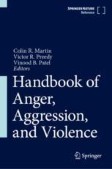Search
Search Results
-
In vivo versus imaginal: Comparing therapists’ willingness to engage in both forms of exposure therapy for repugnant obsessions
Repugnant obsessions are a common theme of intrusions in obsessive-compulsive disorder and are typically ego-dystonic. Exposure and response...
-
Thinking About Disgust: Cognitive Processes Mediate the Associations Between Disgust Proneness and OCD Symptom Domains
The present study explored selected cognitive domains in the relationship between disgust proneness and OCD symptomatology, investigating the...

-
Diagnostic Differential Between Pedophilic-OCD and Pedophilic Disorder: An Illustration with Two Vignettes
Despite the prevalence of atypical sexual thoughts in OCD presentations, research suggests that treatment providers often misclassify OCD with...
-
The Relationship Between Obsessive-Compulsive Disorder and Aggression
The relationship between anger and Obsessive-Compulsive Disorder is complex. In literature, there are several studies trying to define this...
-
The Relationship Between Obsessive-Compulsive Disorder and Aggression
The relationship between anger and Obsessive-Compulsive Disorder is complex. In literature, there are several studies trying to define this...
-
Yet You May See the Meaning of Within: The Role of Identity Concerns and the Self in Psychopathology
Concerns and processes regarding one’s identity and “self” are arguably a central component of existential concerns within humankind. This chapter...
-
The links between disgust, feared selves and contamination fear: a mediation path-analytic model
A large body of work has highlighted the role of disgust in contamination-related OCD. However, there appears to be a lack of research examining the...

-
The Experience of Being Emotionally Maltreated and Self-regulatory Strategies in Obsessive-compulsive Disorder: Pathways to Depressive Symptoms
The contribution of childhood emotional maltreatment to depressive symptoms has been well-established in previous research. However, there is a lack...

-
COVID-19 related stress and fears of contamination: the impact of feared self-perceptions
Specific concerns have been raised for those suffering from obsessive-compulsive disorder (OCD) during the COVID-19 pandemic, particularly those...

-
Intrusive thoughts in patients with obsessive–compulsive and major depressive disorders and non-clinical participants: A comparison using the International Intrusive Thoughts Interview Schedule
Unwanted intrusive thoughts (UITs) have been studied in obsessive–compulsive disorder (OCD) but, despite the relationship between OCD and depression,...

-
Dispositional and Experimentally Induced Mindfulness Are Distinctly Associated with Obsessive Compulsive Symptoms
ObjectivesDespite growing research on mindfulness-based interventions for obsessive compulsive disorder (OCD), it remains unknown which aspects of...

-
‘Terminal anorexia’: a lived experience perspective on the proposed criteria
In an article (Asaria in J Eat Disord 11:107, 2023) recently published by the Journal of Eating Disorders, I expressed my lived experience views on...
-
Core Motivations of Childhood Obsessive-Compulsive Disorder: The Role of Harm Avoidance and Incompleteness
In an effort to improve patient conceptualization and targeted treatment, researchers have sought to accurately classify OCD subtypes. To date, the...

-
Sexual Trauma, Cognitive Appraisals, and Sexual Intrusive Thoughts and Their Subtypes: A Moderated Mediation Analysis
The relationships between sexual trauma, cognitive appraisals, and subtypes of sexual intrusive thoughts have not been adequately examined in the...

-

-
The Relationship Between Affect Intolerance, Maladaptive Emotion Regulation, and Psychological Symptoms
Affect intolerance (AI), one’s perceived sensitivity to, and intolerance of, unpleasant emotional states, is a risk and maintenance factor of...

-
Looming Vulnerability in Obsessive Compulsive Disorder
Obsessive compulsive disorder (OCD) is characterized by the presence of recurrent obsessions and/or compulsions that are time consuming (i.e., occupy...
-
Pedophilia-Themed Obsessive–Compulsive Disorder: Assessment, Differential Diagnosis, and Treatment with Exposure and Response Prevention
Fears of sexually harming children are fairly common among clients suffering from obsessive–compulsive disorder (OCD), yet these symptoms are largely...
-
Thoughts and Thoughts about Thoughts: the Relative Contribution of Obsessive Beliefs and Metacognitive Beliefs in Predicting Obsessive-Compulsive Symptom Dimensions
The cognitive model of obsessive-compulsive disorder emphasizes the importance of “obsessive beliefs” (e.g., about threat/responsibility,...
-
A critical inquiry into marble-burying as a preclinical screening paradigm of relevance for anxiety and obsessive–compulsive disorder: Map** the way forward
Rodent marble-burying behavior in the marble-burying test (MBT) is employed as a model or measure to study anxiety- and compulsive-like behaviors or...

